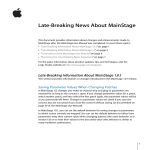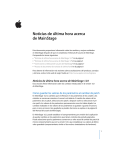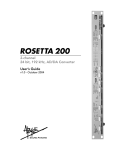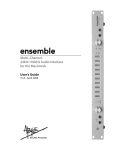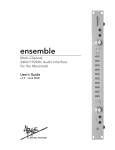Download Apogee Duet 2 User manual
Transcript
MainStage 2 Working with Apogee Hardware Copyright © 2011 Apple Inc. All rights reserved. Your rights to the software are governed by the accompanying software license agreement. The owner or authorized user of a valid copy of MainStage software may reproduce this publication for the purpose of learning to use such software. No part of this publication may be reproduced or transmitted for commercial purposes, such as selling copies of this publication or for providing paid for support services. The Apple logo is a trademark of Apple Inc., registered in the U.S. and other countries. Use of the “keyboard” Apple logo (Shift-Option-K) for commercial purposes without the prior written consent of Apple may constitute trademark infringement and unfair competition in violation of federal and state laws. Every effort has been made to ensure that the information in this manual is accurate. Apple is not responsible for printing or clerical errors. Note: Because Apple frequently releases new versions and updates to its system software, applications, and Internet sites, images shown in this manual may be slightly different from what you see on your screen. Apple 1 Infinite Loop Cupertino, CA 95014 408-996-1010 www.apple.com Apple, the Apple logo, FireWire, Logic, and MainStage are trademarks of Apple Inc., registered in the U.S. and other countries. Other company and product names mentioned herein are trademarks of their respective companies. Mention of third-party products is for informational purposes only and constitutes neither an endorsement nor a recommendation. Apple assumes no responsibility with regard to the performance or use of these products. Contents Preface 5 5 5 6 An Introduction to Working with Apogee Hardware About Using Apogee Hardware About the MainStage Documentation Additional Resources Chapter 1 7 7 9 9 14 Using Apogee’s Ensemble Overview of the Apogee Control Panel Apogee Ensemble Global Parameters Apogee Ensemble Units Parameters Apogee Ensemble Setup Buttons Chapter 2 15 15 17 18 18 Using Apogee’s Duet Overview of the Apogee Control Panel Apogee Duet Input Parameters Apogee Duet Output Parameters Apogee Duet Meter Parameters Chapter 3 19 19 20 21 Using Apogee’s ONE Overview of the Apogee Control Panel Apogee ONE Input Parameters Apogee ONE Output Parameters Chapter 4 23 Using Apogee’s GiO 23 Apogee GiO Control Panel 3 Preface An Introduction to Working with Apogee Hardware Apogee digital audio hardware offers a number of advanced features that can be controlled by MainStage, which provides a dedicated control panel used to directly configure Apogee’s Ensemble, Duet, ONE, and GiO hardware. Note: The control panel and associated menu options are only available if supported Apogee hardware is installed correctly with your system. For further information on installation, see the manuals supplied with your Apogee device. This preface covers the following: • About Using Apogee Hardware (p. 5) • About the MainStage Documentation (p. 5) • Additional Resources (p. 6) About Using Apogee Hardware This guide covers the setup and use of the following Apogee hardware devices in MainStage. • Ensemble: See Using Apogee’s Ensemble. • Duet: See Using Apogee’s Duet. • ONE: See Using Apogee’s ONE. • GiO: See Using Apogee’s GiO. About the MainStage Documentation MainStage comes with various documents that will help you get started as well as provide detailed information about the included applications. • MainStage User Manual: This manual provides comprehensive instructions for creating MainStage concerts and using MainStage with your instruments, microphones, and other music gear when you perform live. • Exploring MainStage: This booklet provides a fast-paced introduction to the main features and tasks in MainStage, encouraging hands-on exploration for new users. 5 • Logic Pro Instruments: This manual provides comprehensive instructions for using the powerful collection of instruments included with MainStage. • Logic Pro Effects: This manual provides comprehensive instructions for using the powerful collection of effects included with MainStage. • Working with Apogee Hardware: This manual describes the use of Apogee hardware with MainStage. Additional Resources Along with the documentation that comes with MainStage, there are a variety of other resources you can use to find out more. Release Notes and New Features Each application offers detailed documentation that covers new or changed features and functions. This documentation can be accessed in the following location: • Click the Release Notes and New Features links in the specific application’s Help menu. MainStage Website For general information and updates, as well as the latest news on MainStage, go to: • http://www.apple.com/logicpro/mainstage Apple Service and Support Websites For software updates and answers to the most frequently asked questions for all Apple products, go to the general Apple Support webpage. You’ll also have access to product specifications, reference documentation, and Apple and third-party product technical articles. • http://www.apple.com/support For software updates, documentation, discussion forums, and answers to the most frequently asked questions for MainStage, go to: • http://www.apple.com/support/mainstage For discussion forums for all Apple products from around the world, where you can search for an answer, post your question, or answer other users’ questions, go to: • http://discussions.apple.com 6 Preface An Introduction to Working with Apogee Hardware Using Apogee’s Ensemble 1 Apogee Ensemble hardware can be controlled by MainStage. This chapter covers the following: • Overview of the Apogee Control Panel (p. 7) • Apogee Ensemble Global Parameters (p. 9) • Apogee Ensemble Units Parameters (p. 9) • Apogee Ensemble Setup Buttons (p. 14) Overview of the Apogee Control Panel The Apogee control panel automatically displays the parameter set that applies to your connected audio device. µ To open the Apogee control panel In MainStage: Choose MainStage > Open Apogee Control Panel. 7 The Ensemble control panel is divided into three parameter groups. From top to bottom, these are Global, Units, and Setup. • Global parameters, at the top of the window, are only relevant if more than one Ensemble device is connected to your system; they define how several devices work together. See Apogee Ensemble Global Parameters. • Units parameters, shown in the center of the window, are used to configure individual hardware units. There are three tabs; General, Input, and Output. See Apogee Ensemble Units Parameters. • Setup parameters, shown at the bottom of the window, allow you to save and load different Apogee hardware configurations. See Apogee Ensemble Setup Buttons. 8 Chapter 1 Using Apogee’s Ensemble Apogee Ensemble Global Parameters The Global parameters at the top of the Apogee hardware control panel determine which Apogee Ensemble hardware device is used. Note: Only one Apogee FireWire device can be controlled at a time. • Unit Select pop-up menu: The Unit Select pop-up menu defines the hardware device (when multiple units are connected). The parameters of the selected device are displayed in the tabs below. • Identify Unit checkbox: Select the Identify Unit checkbox to illuminate all LEDs on the corresponding hardware interface. • Loop Sync Master pop-up menu: Loop Sync Master facilitates the proper clocking of multiple units. It allows simple reconfiguration of clock signals, accommodating nonsynchronous digital inputs on all connected units. Choose the hardware unit that should be used as the clock master from the Loop Sync Master pop-up menu. Once a device is designated as master, all other units are automatically locked to its Word Clock. Note: Multiple Apogee device configuration (and interaction between Apogee devices) is determined by the Apogee driver version. Refer to the information included with the Apogee driver or device for details. • Disable Loop Sync checkbox: Select the Disable Loop Sync checkbox to manually adjust synchronization settings. Apogee Ensemble Units Parameters The Units parameters determine the behavior of individual hardware units installed in your system. These parameters are spread over three tabs: • General tab. See Apogee Ensemble General Parameters. • Inputs tab. See Apogee Ensemble Inputs Parameters. • Outputs tab. See Apogee Ensemble Outputs Parameters. Chapter 1 Using Apogee’s Ensemble 9 Apogee Ensemble General Parameters Click the General tab to set hardware features such as the clock source, UV22HR dithering algorithm, and level meter behavior. • Source pop-up menu: Sets the clock source for the chosen unit. Options are Internal, Optical, Coax, and Word Clock. • Optical In and Optical Out pop-up menus: Choose the protocol for the optical input and output channels. Options are ADAT/SMUX and S/PDIF. • UV22HR pop-up menu: Choose the target signal path for the UV22HR dithering algorithm. Options are Off, Analog In 1–2, Analog In 3–4, Analog In 5–6, Analog In 7–8, Optical In 1–2, Optical In 3–4, Optical In 5–6, Optical In 7–8, S/PDIF In, and S/PDIF Out. • Conversion and SRC Rate pop-up menus: The Conversion pop-up menu allows you to activate or deactivate sample rate conversion for the S/PDIF Input or Output. If sample rate conversion is activated for the S/PDIF Out channel, you can set the destination sample rate in the SRC Rate pop-up menu. • Level Meter Display pop-up menu: Determines the type of metering display shown on the front panel of your Ensemble. Options are Input Level, Output Level, or Off. 10 Chapter 1 Using Apogee’s Ensemble • Hold and Clear Overloads parameters: Select the Hold Overloads checkbox to permanently display overloads on the Ensemble’s front panel overload LEDs. Click the Clear Overloads button to reset the overload LEDs. • CD Mode checkbox: Select this checkbox to engage CD mode, which sends a 44.1 kHz, 16-bit stereo signal to the S/PDIF output, regardless of the input. Activating this checkbox automatically switches the Conversion pop-up menu to S/PDIF Out, the SRC Rate pop-up menu to 44.1 kHz, and the UV22HR pop-up menu to S/PDIF Out. If you change any of these automatically set parameters, the CD Mode checkbox is disabled. Apogee Ensemble Inputs Parameters Click the Inputs tab to configure the inputs of your Ensemble hardware. The tab contains four identical parameter sets for mic inputs 1 to 4, and a separate parameter section for line inputs 5 to 8. Chapter 1 Using Apogee’s Ensemble 11 Inputs 1 to 4 Inputs 1 to 4 feature built-in pre-amps. These can be configured individually via the four identical sets of Pre-Amp parameters. • Level pop-up menu: Sets the respective channel between mic and line inputs. If you choose the Line option, the +4 dBu and −10 dBV options (shown in the pop-up menu below) are used to set the reference level of the line input. All mic-related settings—Gain, Group, Phase Invert, and 48V Phantom Power—are dimmed. • Gain slider: Sets the gain level of the chosen input (only available for mic channels). • Group pop-up menu: The gain controls of the mic inputs can be assigned to a group. Groups link the Gain sliders of mic inputs. Changing the Gain slider of any mic input assigned to a group also changes the Gain sliders of all mic inputs in the group. Individual gain relationships (relative levels between mic inputs)—at the time the Gain sliders were assigned to the group—are retained. Options are Group 1, Group 2, and None. The Group pop-up menu is only available to channels used as mic inputs. • Soft Limit checkbox: Select to apply Apogee’s soft limiting to the inputs. • Phase Invert checkbox: Select this checkbox to reverse the phase of the input signal. This checkbox can only be activated if the channel is used as a mic input. • 48V Phantom Power checkbox: Select to activate a 48 volt phantom power supply for inputs 1 to 4. This checkbox can only be activated if the channel is used as a mic input. Line Inputs 5 to 8 The Analog Line Input section offers the following parameters for line inputs 5 to 8: • Level pop-up menu: Sets the input level of line inputs 5 to 8. Options are +4 dBu and −10 dBV. • Soft Limit checkbox: Select to apply Apogee’s soft limiting to the analog line inputs. 12 Chapter 1 Using Apogee’s Ensemble Apogee Ensemble Outputs Parameters Click the Outputs tab to configure the outputs of your Ensemble hardware. • Headphone 1 and 2 Source pop-up menus: Determine which output pair is sent to the respective headphone output. Options are Analog Out 1–2, Analog Out 3–4, Analog Out 5–6, Analog Out 7–8, Optical Out 1–2, Optical Out 3–4, Optical Out 5–6, Optical Out 7–8, and S/PDIF Out. • Headphone 1 and 2 Level sliders: Set the level of the respective headphone output. • Format pop-up menu: Choose the output channels that you want to control with the Main Output Level slider. Values are Stereo, 5.1 Surround, and 7.1 Surround. • Output Level slider: Sets the level of channels chosen in the Format pop-up menu. • Channel pop-up menus: Choose either +4 dBu or −10 dBV in the respective Channel pop-up menu to determine the reference level for each of the eight analog line outputs. Chapter 1 Using Apogee’s Ensemble 13 Apogee Ensemble Setup Buttons The bottom of the Apogee hardware control panel offers three buttons that allow you to save and load your configuration settings. • Recall Setup from Project button: Loads the configuration saved with a project. • Load Setup button: Opens a dialog, allowing you to load a stored configuration. • Save Setup button: Opens a dialog, allowing you to save the current configuration. 14 Chapter 1 Using Apogee’s Ensemble Using Apogee’s Duet 2 Apogee Duet hardware can be controlled by MainStage. This chapter covers the following: • Overview of the Apogee Control Panel (p. 15) • Apogee Duet Input Parameters (p. 17) • Apogee Duet Output Parameters (p. 18) • Apogee Duet Meter Parameters (p. 18) Overview of the Apogee Control Panel The Apogee control panel automatically displays the parameter set that applies to your connected audio device. µ To open the Apogee control panel Choose MainStage > Open Apogee Control Panel. 15 The Duet control panel is divided into three parameter groups. From top to bottom: Input, Output, and Meter. • Input parameters: Use to configure the inputs of your Duet interface. See Apogee Duet Input Parameters. • Output parameters: Use to configure the outputs of your Duet interface. See Apogee Duet Output Parameters. • Meter parameters: Use to configure the display of your Duet interface. See Apogee Duet Meter Parameters. 16 Chapter 2 Using Apogee’s Duet Apogee Duet Input Parameters The input parameters control aspects such as input level switching, input phase switching, and phantom power activation. • Group Inputs checkbox: Select to link the Gain sliders for the two inputs. • Input 1 and 2 Gain sliders: Set the amount of gain applied to the input signal when instrument or XLR Mic is chosen in the Level pop-up menu. • Input 1 and 2 Level pop-up menus: Choose between instrument, mic, and line inputs for the respective channel. • The Instrument input setting activates the 1/4 inch input. • The Mic and Line settings activate the XLR input. • You can choose between two line options, +4 dBu and −10 dBV, when setting the reference level of the line input. All mic and instrument-related settings—Gain, Phase Invert, and 48V Phantom Power—are dimmed. • Input 1 and 2 Phase Invert checkboxes: Select the respective checkbox to reverse the phase of the input signal (only available if the channel is used as an instrument or mic input). • Input 1 and 2 48V Phantom Power checkboxes: Select to activate a 48 volt phantom power supply for the respective input. This checkbox is only available if the channel is used as a mic input. Chapter 2 Using Apogee’s Duet 17 Apogee Duet Output Parameters The output parameters determine the output and muting behavior of the Duet. • Level slider: Sets the output level. If you set the (Output) Level pop-up menu to Instrument Amplifier, this slider has no effect. • Level pop-up menu: Determines the output. You can choose between Line −10 dBV and Instrument Amplifier. • Mute checkbox: Mutes the output chosen in the Mute Behavior pop-up menu. • Mute Behavior pop-up menu: Determines which output is muted when the Mute checkbox is selected. Choose the Toggle Main Output/Headphones setting to alternate between muting the main output and the headphone output—by selecting the Mute checkbox. Apogee Duet Meter Parameters The meter parameters are used to set general metering behavior and to link Gain for multiple inputs. • Display shows buttons: Select either the Input or Output button to determine the level meter display shown on your Duet interface. • Peak Hold buttons: Select either button to determine the amount of time that peaks are held on the Duet display. 18 Chapter 2 Using Apogee’s Duet Using Apogee’s ONE 3 Apogee ONE hardware can be controlled by MainStage. This chapter covers the following: • Overview of the Apogee Control Panel (p. 19) • Apogee ONE Input Parameters (p. 20) • Apogee ONE Output Parameters (p. 21) Overview of the Apogee Control Panel The Apogee control panel automatically displays the parameter set that applies to your connected audio device. µ To open the Apogee control panel Choose MainStage > Open Apogee Control Panel. The ONE control panel is divided into two parameter groups: Input and Output. • Input parameters: Use to configure the inputs of your ONE interface. See Apogee ONE Input Parameters. • Output parameters: Use to configure the outputs of your ONE interface. See Apogee ONE Output Parameters. 19 Apogee ONE Input Parameters The input parameters control aspects such as input level switching and phantom power activation. • Input pop-up menu: Choose one of the following input sources: • Int(ernal) Mic activates the built-in electret microphone. • Ext(ernal) Mic activates the XLR input. • External Phantom-powered Mic (Ext 48V Mic) activates a 48 volt phantom power supply for the XLR input. This setting applies only when a microphone is connected to the XLR input. • Inst(rument) activates the 1/4 inch input. • Gain slider: Determines the amount of gain applied to the input signal. 20 Chapter 3 Using Apogee’s ONE Apogee ONE Output Parameters The output parameters determine the output format and level. • Output pop-up menu: Determines the output gain. You can choose between Speaker/Headphone Out (Stereo) and Instrument Amp (Amp). Note: If Instrument Amp is chosen as the output, the Level slider is dimmed. • Mute checkbox: Mutes the output. • Level slider: Sets the output level. Chapter 3 Using Apogee’s ONE 21 Using Apogee’s GiO 4 Apogee GiO hardware can be controlled by MainStage. This chapter covers the following: • Apogee GiO Control Panel (p. 23) Apogee GiO Control Panel The Apogee control panel automatically displays the parameter set that applies to your connected audio device. µ To open the Apogee control panel Choose MainStage > Open Apogee Control Panel. The GiO control panel is divided into two parameter groups: Input and Output. • Instrument Gain slider: Use this slider to determine the amount of gain applied to the input signal.. • Level slider: Sets the output level. • Mute checkbox: Mutes the output. • Output buttons: Select either Line/Headphone or Instrument Amplifier to determine the output gain. Note: If Instrument Amplifier is chosen as the output, the Level slider is dimmed. 23

























